 |
|
NIPPONIA No.24 March 15, 2003
|
|
Special Feature*
Matagi hunters
Written by Hijikata Masashi
Photos by Okuno Yasuhiko
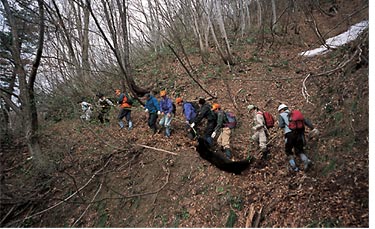 |
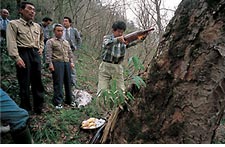
Left: Hunters hauling out a shot bear.
Above: The hunters are sure to go to a sacred tree to give thanks to nature, before dividing up the bear.
|
Two shots ring out, followed by echoes striking the mountain slopes. A moment later, I hear over the walkie-talkie, "We've got a bear!" The men seem to fly across the snow that still remains on the steep slope of the valley, heading for an awesome Asian black bear stretched out on the ground.
The place is Yamakumata, in Sanboku-machi, Niigata Prefecture. The villagers here are keeping alive the traditions of the matagi hunters of the mountains. Years ago, hunting was a way of life for some in the Tohoku region, but today the men hold down other jobs, like farming, forestry, or working for the government. Matagi traditions live on when they all band together for the hunt. For them, hunting bears is a festive event celebrating the arrival of spring. After the hunt, the men will pay their respects at a sacred tree some distance from the village, giving thanks for the gifts of nature.
The name of the place here, Yamakumata, is written with three characters: yama (mountain), kuma (bear), and ta (rice field). "The name probably comes from the fact that all we have here are those three things," laughs Otaki Kuniyoshi, who is in charge of the hunt. But the mountain village obviously has more than that, because it attracts many tourists from the cities.
Otaki and his friends established the Beech Forest Hiking Association to bring tourists from urban areas and guide them on mountain tours. Women from the city come to learn a traditional weaving technique to make cloth from the bark of the Japanese linden tree. There is pride in Otaki's voice when he says, "We don't have many of the things in a big city, but we have everything you'll ever really need." 
Gifts from the forest
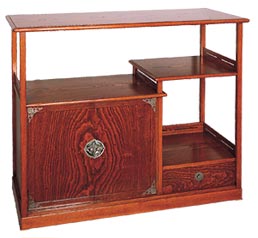 |
Furniture
Wood from trees like paulownia, katsura and zelkova is ideal for furniture and wooden craftwork, because it has a beautiful grain and doesn't split easily. This decorative shelving is made from zelkova wood.
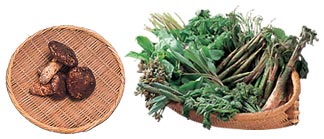 |
|
Mushrooms
and edible
wild plants
Japan has hundreds of edible mushrooms and wild plants. Matsutake mushrooms (left) are prized even more
than truffles.
|
|
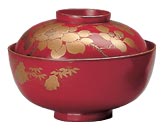 |
|
Lacquerware
Lacquerware has a unique luster and is remarkably hard. It is one of Japan's traditional handcrafts, and is made in many parts of Japan. One place famous for lacquerware is Wajima in Ishikawa Prefecture. (Photo: Nakagawa Tadaaki)
|
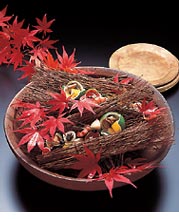 |
|
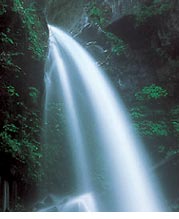 |
|
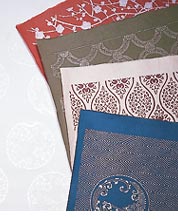 |
Leaves
Since ancient times, the Japanese have used maple leaves to decorate servings and plants like bamboo grass to add flavor. This type of forest product is now so popular that some companies in this business bring in up to 200 million yen a year.
|
|
Underground springs
Large wooded areas have tremendous reserves of groundwater, and there are natural springs all over Japan.
|
|
Washi paper
Japanese paper (washi) is made from fibrous plants like paper mulberry or mitsumata. It is mainly used in shoji and fusuma sliding doors in houses, and for calligraphy and the tea ceremony.
|
|
 |